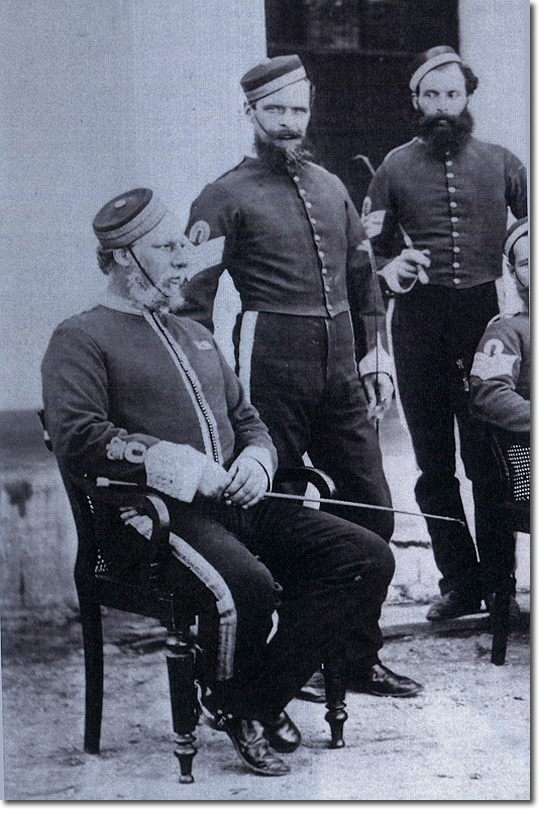|
|

 |
|
The fierce-looking elderly man sitting in this photo is a Warrant Officer wearing an officer-style stable jacket that is scarlet, laced with gold and has the 60 small ball buttons down the front. He also has a gold stripe on his trousers instead of the white stripe worn by the ranks below him.' There are four gold laced inverted chevrons on his right forearm just above the gold lace edge of his white cuff. Above the stripes is an embroidered horseshoe badge to denote his occupation as farrier. This badge is also on the upper arms of the farrier sergeants. He wears an embroidered Victorian crown badge above the horseshoe. His pill-box cap is blue with two gold cap-bands, the upper one slightly slimmer than the lower one. The complete photo shows a group of 7 men altogether, six sergeants and the Farrier Major.' Three of them have no medal ribbon but the other four have at least one ribbon.' So three of them joined the regiment after the Indian Mutiny campaign.
The authoritative book on NCO arm badges by David Linaker and Gordon Dine has a valuable Annex B which explains the history of WO and NCO ranks from 1800 to modern times.' The Cavalry Regulations of 1795 listed the Farrier Major as having the status of a sergeant and wearing two white chevrons. The rank lapsed c1800 but was re-established in 1852.' The Farrier Major then had the status of sergeant with a horseshoe badge and three chevrons inverted on the right arm. After 1860 he ranked equally with the QMS with the status of First Class Staff and had four inverted chevrons. No mention is made of a crown, but the Bays did have a tradition of NCOs wearing a crown over their stripes.' However the other NCOs in the photo do not have crowns so the tradition does not date back as far as the 1860s. This status and rank lasted until the changes of 1881 when the rank of WO was introduced. The appointment was titled Farrier Quartermaster Sergeant (FQMS) with the status of 1st Class Staff, one step below Warrant Officer. The badges remained the same.' In 1904 the title changed to Farrier Sergeant Major (FSM) with the status of WO. The stripes were removed and the Crown with horseshoe badge below was worn on the right forearm. In 1915 there was a change along with the introduction of WO2. The Farrier Sergeant Major was now WO1 with a Royal Arms badge above the horseshoe.' With mechanisation the appointment of FSM, along with others, became redundant. Suggested Reading Cavalry Warrant Officers' and Non-Commissioned Officers' Arm Badges'by David Linaker and Gordon Dine (Military Historical Society 1997)' |
Armed Forces | Art and Culture | Articles | Biographies | Colonies | Discussion | Glossary | Home | Library | Links | Map Room | Sources and Media | Science and Technology | Search | Student Zone | Timelines | TV & Film | Wargames Library | Search | TV & Film | Wargames
